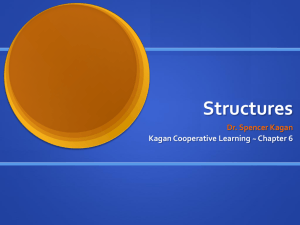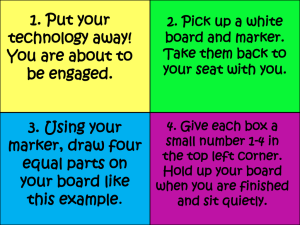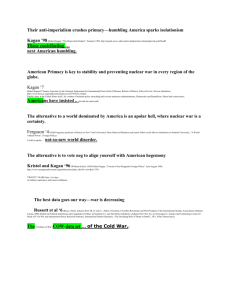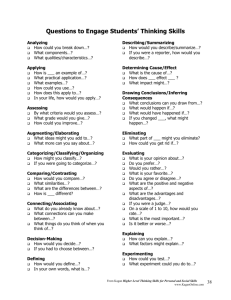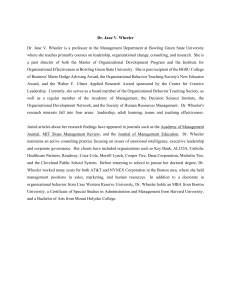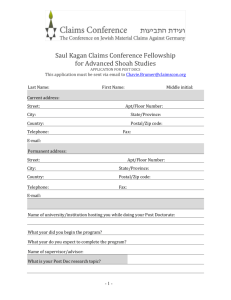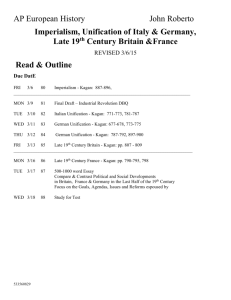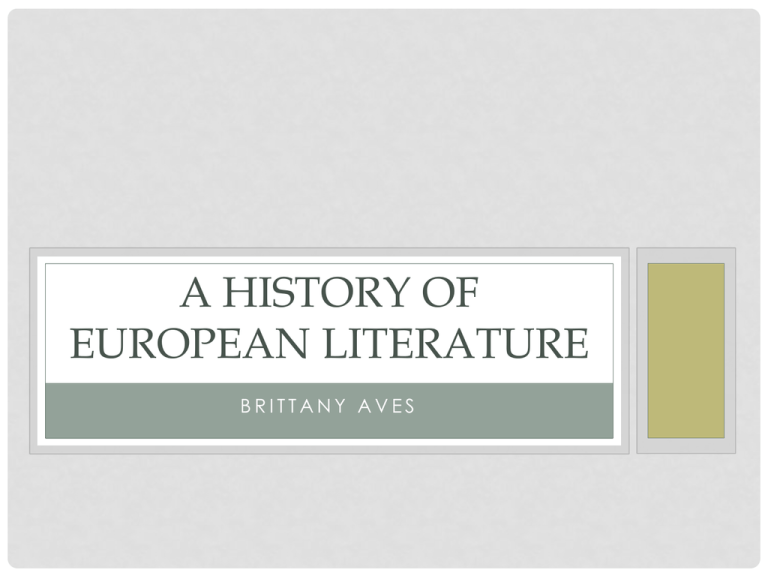
A HISTORY OF
EUROPEAN LITERATURE
BRITTANY AVES
PERIODS OF LITERATURE:
• Renaissance: 1400’s-1600’s
• Enlightenment: 1650- 1800
• Romanticism: 1798 – 1870
• Realism/Naturalism: 1850-1914
• Victorian Period: 1832- 1901
• Modernism: 1870’s – 1965
• Post-Modernism: 1965- Present
(Wheeler, Lit. Timeline, Rickard)
RENAISSANCE (1400’S-1600’S)
• The Renaissance was a period of transition that left
behind the medieval ways of the past and launched
society towards a modern world.
• At this time, people were concerned with individualism,
as well as self and societal improvement.
• Many writers produced pieces that catered to wealthy
patrons who commissioned their work.
• Johannes Gutenberg created the printing press in 1440,
allowing for mass production of pamphlets and novels.
• This gave people an increased opportunity to read
publications of various authors like Petrarch and
Boccaccio.
(Wheeler, Kagan)
RENAISSANCE WORKS OF NOTE
"Paradise Lost," Stanford University Libraries
• Petrarch: Canzoniere, Trionfi
• Giovanni Boccaccio: The
Decameron
• Niccolo Machiavelli: The Prince
• John Milton: Paradise Lost
• Miguel de Cervantes, Don Quixote
• Dante Alighieri: Divina Commedia
• Sir Thomas More, Utopia
• William Shakespeare: King Lear,
Hamlet, Macbeth, Romeo and
Juliet
• Christopher Marlowe: Doctor
Faustus (Wheeler, Lit. Timeline, Rickard)
RENAISSANCE
• Authors of Renaissance literature presented many
revolutionary ideas during this period in history (14851680 C.E.) that focused on the central topics of
humanism, classicism and secularism.
• Humanism: People were intrigued by the idea of human
power. Humanistic works focused on human traits and
abilities.
• Classicism: Authors drew on antiquity, were inspired by
the works of the philosophers in ancient Greece and
Rome.
• Secularism: Dealt with issues of politics and personal
concern outside of the realm of religion.
(Wheeler, Kagan)
RENAISSANCE MEN
• Erasmus: Known as the “Christian Gentleman” (Eder, 46)
embodied the essential traits of the Renaissance
humanist. Erasmus translated the bible into new Greek
and Latin editions and was an opinionated critic of the
religious figures of the time. He criticized those who
abused their religious power, and satirized the overall
hypocrisy of the age. Many historians hypothesize that
Erasmus planted the seeds for Martin Luther’s radical
protestant reformation.
• Petrarch: Considered to be the first modern writer.
Known for his sonnets and other works, which evaluated
life and the human condition.
(Eder, Kagan)
RENAISSANCE MEN
• Machiavelli: The author of The Prince, Machiavelli was
likely a sarcastic author, rather than the brutal figure he
is perceived to be. He penned the words “The end
justifies the means” in his political ‘how-to’ that
suggested that rulers merely rule without moral
judgment.
• Boccaccio: Contemporary of Petrarch, known for the
Decameron, a collection of stories that provide a
commentary on the human condition.
• Petrarch: Considered to be the first modern writer.
Known for his sonnets and other works, which evaluated
life and the human condition.
(Eder, Kagan)
ENLIGHTENMENT (1650- 1800)
• A ‘print culture’ emerged, the
volume of printed material
dramatically increased.
• Key areas of discussion during
this period include:
i.
Human nature
ii.
The relationship between
government and its
people
iii. Property
iv. Natural laws and rights
v.
Organized religion
• The enlightenment was
a period of great
change in policies and
beliefs politically,
economically, and
socially.
• Philosophes criticized
the status quo.
• They produced many
theories in literature for
the betterment of
humankind.
(Eder, Kagan)
ENLIGHTENMENT WORKS OF NOTE
• Thomas Hobbes: Leviathan
• Jean-Jacques Rousseau: The Social Contract, Emile, and
Confessions.
• Denis Diderot: Encyclopedie
• Mary Wollstonecraft: A Vindication of the Rights of
Women
• Jonathan Swift: Gulliver’s Travels
• Voltaire: Candide
• Adam Smith: The Wealth of Nations
• Daniel Defoe: Robinson Crusoe
• Montesquieu: Spirit of the Laws
• John Locke: An Essay Concerning Human Understanding
(Wheeler, Lit. Timeline, Rickard)
ENLIGHTENMENT THINKERS
• Rousseau: Developed the idea of the Noble Savage,
and pushed for individualism, as well as individual
human rights. His influence was profound, and his
distrust of civilization in general led to new educational
and political practices across Europe.
• Voltaire: Staunch deist, advocate of human rights and
fighter of injustice. He adamantly fought rigid religion
and governmental abuse of power. He opposed
censorship and was a fierce critic of society.
• Smith: Smith advocated a “Laissez-faire” system of
economics in which the government should stay out of
the day to day economic affairs, allowing for natural
regulation in the free market economy.
(Eder, Kagan)
ENLIGHTENMENT THINKERS
• Newton: Synthesized Kepler and Galileo’s ideas into his
Laws of Motion, pioneered physics and calculus.
• Locke: Locke believed in the idea of a social contract;
that the government has a duty to its people, and if the
government is not able to do what is required, it should
be altered by the people. Also influential, his term
“Tabula Rasa,” a phrase that represented the idea that
people are born a ‘blank slate,’ and over time are
altered to become good or evil depending on their
environment. Locke believed that people achieve
equality as a result of their rights, not their abilities. He
believed that humans should have the natural rights of
life, liberty, and property.
(Eder, Kagan)
ENLIGHTENMENT THINKERS
• Hobbes: Hobbes believed that, in order for the
government to reach its potential, citizens of the state
ought to give up some rights, in return for protection. He
believed in an absolute monarchy with one state
religion, in order for any country to be strong and
unified.
• Wollstonecraft: British writer, thought to be the first
feminist.
• Montesquieu: Political conservative, anti-aristocracy,
brought forth the idea for the separation of powers in
the government, his ideas were extremely influential in
the writing of the American constitution later on. His
book, Spirit of the Laws, was possibly the most influential
book of the century.
(Eder, Kagan)
IMPORTANT ENLIGHTENMENT QUOTES
“Man is born free, but everywhere he is in chains” -Rousseau
“Cogito ergo sum” (“I think; therefore I am”)-Descartes
“Knowledge is power” - Bacon
"Freedom is a gift from heaven, and every individual of the
same species has the right to enjoy it as soon as he is in
enjoyment of his reason.“- Diderot
• “I disapprove of what you say, but I will defend to the death
your right to say it.”- Voltaire
• “No one ought to harm another in his life, health, liberty or
possessions”- Locke
• “When America, the Negro countries…and so forth were
discovered, they were to them [the Europeans], countries
belonging to no one, since they counted the inhabitants as
nothing.”- Kant
•
•
•
•
(Eder, Kagan)
ROMANTICISM (1798 – 1870)
• The term, “Romanticism” was originally used to describe
literature in 17th century Europe that writers saw as
unrealistic, filled with emotions, or over the top in its
stylistic tendencies.
• Many people have come to used the terms “romantic”
and “gothic” interchangeably to describe this type of
literature. Romantic is the broad literary period/
category, gothic literature is a subset of this movement.
• This movement, centered in Germany, played off of the
type of material often seen in medieval romances.
• Many romantic novels delved into dramatic new
subject matter, often focusing on a character who lived
on the edge of, or outside of normal society.
(Kagan, Hauser)
ROMANTICISM
• Romantic-style literature caught on first in Germany and
England. In contrast to the systematic view, used by
Enlightenment thinkers, who saw the universe as a
machine; romanticism saw the world as organic, like a
tree full of life.
• This genre disregarded previous rules for form and
technique, giving free reign to the reader’s imagination.
• English writers believed that their writing was enhanced
by following whatever whim their creative impulses felt.
• The movement took longer, however to catch on in
France. It was not until 1816 that a French writer, Henri
Beyle, self-identified as a romantic writer that the style
began to take hold. (Kagan, 643-648)
ROMANTICISM
Key ideals and identifying
factors of the romantic
literary movement:
• Emphasis on emotion
• Idealized nature
• Importance of the
individual
• Emphasis on imagination
• Dramatic/ bold subject
matter
• Often uses a ‘dark’ aura
to build suspense
Elements of gothic literature:
• Evil characters
• Evil actions or events
• Spooky or lonely setting
• Appearances of ghosts or
spirits
• Mood of horror or terror
• Magical, mysterious, or
supernatural occurrences
• Subjects such as guilt,
punishment and penance.
(Hauser)
ROMANTICISM WORKS OF NOTE
•
•
•
•
•
•
•
•
Horace Walpole: The Castle of Otranto
Victor Hugo: Les Miserables
Mary Shelley: Frankenstein
Samuel Taylor Coleridge: The Rime of the Ancient
Mariner, Lyrical Ballads
Lord Byron: Don Juan, Childe Harold’s Pilgrimage
William Wordsworth: The Prelude
Fredrick Schlegel: Lucinde
Johann Wolfgang von Goethe: The Sorrows of
Young Werther, Faust
• Georg Wilhelm Friedrich Hegel: Phenomenology of Mind
(Wheeler, Lit. Timeline, Rickard)
REALISM/NATURALISM (1850-1914)
• Gave a look into the dull verities of bourgeois life.
• Used a pseudo-scientific perspective to bring
objectivity to the hypocrisy and brutality of the time.
• Rejected the idealization that was used previously
in the Romantic movement, instead turning to the
dark reality of the middle class way of life.
• Realist writers often broached the subject of the
flaws of society, exhibiting “alcoholism, prostitution,
adultery, labor strife” (Kagan, 807) and other topics
that had not previously been brought to light.
• Writers like Zola and Ibsen worked to uncover the
unpleasant immorality of the middle-class.
(Kagan)
REALISM WORKS OF NOTE
• Emile Zola: L’Assommoir
• Leo Tolstoy: War and Peace
• Claude Bernard: Introduction to the Study of
Experimental Science
• Fyodor Dostoyevsky: Crime and Punishment
• Charles Dickens: The Adventures of Oliver Twist
• George Bernard Shaw: Mrs. Warren’s Profession
• Two pieces of particular importance were Madame
Bovary, by Gustave Flaubert and A Doll’s House, by
Henrik Ibsen.
(Wheeler, Lit. Timeline, Rickard)
MADAME BOVARY
Madame Bovary, the original ‘realistic’ novel,
depicts a woman who is unsatisfied in her search
for love, both in and outside of her marriage. This
novel pours through the tragic personal details of
a promiscuous bourgeois woman’s life. Ultimately,
Madame Bovary finds that she feels too hopeless
to carry on and chooses to commit suicide. This
grim novel embodies the spirit of the realism
movement, free from the pretense of heroism or
civility- diverging completely from the idealized
literature of the past. (Hawthorne)
A DOLL’S HOUSE
A Doll’s House tells the tale of Nora Helmer, a seemingly
helpless wife, extremely dependent on her husband Torvald
and her domestic life. In reality, her entire life is a ruse to cover
up the fact that she is doing all kinds of desperate things to
repay a loan on which she forged her father’s signature
(without her husband’s knowledge.) As the plot develops, her
façade crumbles. When Torvald realizes that Nora deceived
him for such a long time, he becomes enraged and calls her
unfit to raise his children. When they find out that there will, in
fact, be no consequences for her forgery, he tries to take it all
back. Unfortunately, he had revealed himself to be a selfish,
hypocrite with no regard for her position in the matter. Nora,
unimpressed, leaves Torvald, on a journey to find herself and
become a woman, rather than a ‘doll’ without any illusion of
independence. (Allen, Kashdan)
VICTORIAN PERIOD 1832- 1901
• A form of English realism.
• Often critiqued the cruel reality that middle
class members of society had to face.
• The period of English history between the
passage of the first Reform Bill (1832) and the
death of Queen Victoria (reigned 1837–1901).
• This period has a double-edged connotation; it
is remembered for its strict social, political, and
sexual conservatism, but at the same time, it
saw prolific literary activity and significant social
reform.
(Wheeler, Lit. Timeline, Rickard)
VICTORIAN WORKS OF NOTE
•
•
•
•
•
•
•
•
•
•
William Makepeace Thackeray: Vanity Fair
Robert Louis Stevenson: Treasure Island
Oscar Wilde: The Importance of Being Earnest
George Eliot: Middlemarch
Emily Bronte: Wuthering Heights
Charlotte Bronte: Jane Eyre
Charles Dickens: Oliver Twist, Great Expectations
Gerard Manley Hopkins: Pied Beauty
Anthony Trollope: Chronicles of Barsetshire
Lord Alfred Tennyson: The Charge of the Light
Brigade
(Wheeler, Lit. Timeline, Rickard)
MODERNISM (1870’S – 1965)
• Modernism, like realism, provided critique of morality of
the middle class society.
• Unlike realism, however, Modernism focused on
aesthetics, rather than societal issues.
• Modernism mirrored the upheaval seen in society as a
result of WWI.
• Proponents of Modernism toyed with new forms and
styles of writing, including a technique called stream of
consciousness.
• Developed by Marcel Proust, the ‘stream of
consciousness’ style allowed the author to explore all of
the facets of their thought process without any
suggested formatting rules.
(Wheeler, Kagan)
MODERNISM-STREAM OF
CONSCIOUSNESS
“Novelists have always satisfied our curiosity
about human motivation by revealing the private
thoughts of their characters, but the classic novel
contained this information within an objective
description of their actions and interactions. The
avant garde novelists of the early 20th century
believed that they could get closer to reality not
by ‘telling’ but by ‘showing’ how it is experienced
- subjectively.”
-Author David Lodge, regarding the unique
literary technique
MODERNISM-AN EXAMPLE OF STREAM
OF CONSCIOUSNESS WRITING
• "Everything (he kept saying) is something it isn't. And
everybody is always somewhere else. Maybe it was the
city, being in the city, that made him feel how queer
everything was and that it was something else. Maybe (he
kept thinking) it was the names of the things. The names
were tex and frequently koid. Or they were flex and oid or
they were duroid (sani) or flexsan (duro), but everything
was glass (but not quite glass) and the thing that you
touched (the surface, washable, crease-resistant) was
rubber, only it wasn't quite rubber and you didn't quite
touch it but almost. The wall, which was glass but turned
out on being approached not to be a wall, it was
something else, it was an opening or doorway--and the
doorway (through which he saw himself approaching)
turned out to be something else, it was a wall. And what he
had eaten not having agreed with him."
(opening paragraph of "The Door" by E.B. White. The New
Yorker, 1939)
MODERNISM WORKS OF NOTE
•
•
•
•
•
•
•
•
•
•
Virginia Woolf: A Room of One’s Own, Mrs. Dalloway
James Joyce: Ulysses, Finnegan’s Wake
Marcel Proust: Remembrance of Things Past
George Orwell: Animal Farm
Franz Kafka: The Metamorphosis, The Trial, The
Warden of the Tomb
William Butler Yeats: The Tower
Joseph Conrad: Heart of Darkness
Alfred Doblin: Berlin Alexanderplatz
William Golding: Lord of the Flies
Albert Camus: The Stranger
(Wheeler, Lit. Timeline, Rickard)
POST-MODERNISM – 1965- PRESENT
• Literary and societal response to the elitism of high
modernism, as well as the horrifying events of WWII.
• Characterized by a strange mix of high and low culture.
• Fragmentation, paradox, and narrators that are difficult
to define are common. The style of writing evokes the
absence of tradition in a modern consumer-driven,
technologically based society.
• Authors began to use a jumble of various ingredients,
known as pastiche, that had not been seen as
appropriate for literature before, in order to create a
more complex story, filled with allusions to events and
style of other literary works that took a certain level of
education to recognize or even begin to appreciate.
(Wheeler, Lit. Timeline)
POST-MODERNISM WORKS OF NOTE
•
•
•
•
•
•
•
•
•
•
•
•
Rahld Dahl: Charlie and the Chocolate Factory
Alasdair Gray, Lanark: A Life in Four Books
Alan Moore: Watchmen
Dmitry Galkovsky: The Infinite Deadlock
Umberto Eco: Foucault’s Pendulum
Vladimir Nabokov: Mother Night
John Fowles: The French Lieutenant’s Woman
Venedikt Erofeev: Moscow-Petushki
Walter Abish: How German Is It
Gertrude Stein: The Autobiography of Alice B. Toklas
George Perec: Life: A User’s Manual
Italo Calvino: If on a winter’s night a traveler
(Wheeler, Lit. Timeline, Rickard)
Works Cited
Allen, Rodney. "A Doll's House: A Historical Introduction." Seminar English II. R. J. Reynolds
High School, Winston Salem. Feb.-Mar. 2012. Lecture.
Eder, James M., and Seth A. Roberts. Barron's AP European History. 6th ed. Hauppauge,
NY: Barrons Educational Series, 2012. Print.
Hauser, Kathryn. "The Classic Gothic, Romantic Novel: Mary Shelley's Frankenstein." AP
English Literature. Career Center High School, Winston Salem. Jan.-Feb. 2014.
Lecture.
Hawthorne, Melanie. "Madame Bovary." Magill’s Survey Of World Literature, Revised
Edition(2009): 1-2. Literary Reference Center Plus. Web. 23 Mar. 2014.
Jalic Inc. Literary Periods and Movements Graphical Timeline. Digital image. Onlineliterature.com. The Literature Network, 2011. Web. 10 Mar. 2014.
Kagan, Donald, Steven E. Ozment, and Frank M. Turner. The Western Heritage: Since
1300. 9th ed. Upper Saddle River, NJ: Pearson Prentice Hall, 2007. Print.
Kashdan, Joanne G. "A Doll’s House." Masterplots, Fourth Edition (2010): 1-3. Literary
Reference Center Plus. Web. 23 Mar. 2014.
"Literature Timeline." Literature Timeline. Tappan Zee High School English Department, n.d.
Web. 20 Mar. 2014.
Works Cited
Lodge, David. "1000 Novels Everyone Must Read: The Best Stream-of-Consciousness
Novels." Theguardian.com/us. The Guardian, 19 Jan. 2009. Web. 22 Mar. 2014.
The Mcclatchy Company. "Paradise Lost" 2011. "The American Enlightenment: Treasures
from the Stanford University Libraries", Palo Alto, CA. EbscoHost. Web. 15 Mar.
2014.
Nordquist, Richard. "Stream of Consciousness." About.com Grammar & Composition.
About.com, n.d. Web. 22 Mar. 2014.
Rickard, John, Ph.D., M.A., B.A. Literary History Timeline. Bucknell.edu. Bucknell University,
n.d. Web. 10 Mar. 2014.
Viault, Birdsall S. Modern European History. New York: McGraw-Hill, 1990. Print.
Wheeler, L. K., Dr. Periods of Literature. Web.cn.edu. Dr. Kip Wheeler, Carson-Newman
University, n.d. Web. 15 Mar. 2014.
White, E. B. "The Door." The New Yorker 25 Mar. 1939: 17. The New Yorker Archive. Web.
22 Mar. 2014.

